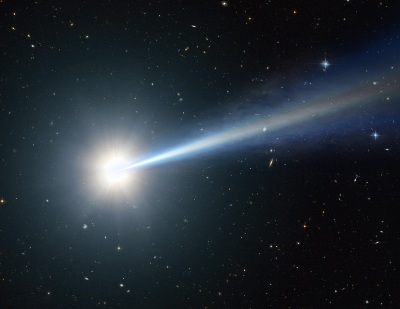By Tushna Commissariat

An artist’s impression of one of the most distant and brightest quasars ever seen. (Courtesy: NASA)
This week marks 50 years since astronomer Maarten Schmidt’s discovery of the quasar, using the giant Palomar Observatory telescope. Quasars or quasi-stellar objects are a kind of active galactic nucleus that astronomers believe are powered by supermassive black holes and are scattered throughout the universe. They have always fascinated me, being some of the brightest, most distant and highly red-shifted astronomical objects in our universe. Over the years, thousands of quasars have been identified and they have dramatically influenced our ideas about the scale of the observable universe and have helped astronomers shed some light on the early universe.
In fact, just this week an international team of researchers announced the discovery of an extremely rare triple quasar system – only the second one observed to date. These systems are considered to be extremely rare and are difficult to spot. By combining multiple telescope observations and advanced modelling, the team – led by Emanuele Farina of the University of Insubria in Como, Italy – was able to discover the triplet quasar, called QQQ J1519+0627. The researchers say that light from the quasars has travelled nine billion light-years to reach us, meaning that it was emitted when the universe was only a third of its current age. Advanced analysis confirmed that what the team found was indeed three distinct sources of quasar energy and that the phenomenon is extremely rare.
So in light of these exciting findings, in this week’s Facebook poll we are asking you to pick your favourite astronomical objects.
Which astronomical objects do you find the most fascinating?
Supernovae
Quasars
Pulsars
Black holes
Exoplanets
Other (please suggest via a comment below)
Please cast your vote by visiting our Facebook page. If you want to pick another favourite, please do post a comment on the poll to let us know.
In last week’s poll we asked you which 20th-century physicist’s life would make the most gripping basis for a children’s novel. Nearly 54% of you voted for the enigmatic physicist Richard Feynman, followed by Albert Einstein (22%) and Marie Curie (12%). Trailing behind were Stephen Hawking (2.75%) and Brian Cox (1.8%). The remaining 6% of people went for the “somebody else” category. Some of the interesting alternatives suggested included George Gamow, Lise Meitner, Maria Goeppert-Mayer, Edward Witten and Carl Sagan.
Thank you for all your participation and we hope to hear from you again in this week’s poll.
Supernovae;
I’ve seen 2 supernova pictures, asymmetrical explosions having one ring another having two rings. Which, look exactly like the subshells d orbital and f orbital of e- probability patterns. ?Dimensional?
Not FB member.
The Einstein Rings and gravitational lensing are fascinating both as tools and events. Especially the ring mirage about LRG 3-757.
APOD 2011 Dec 21 Hubble image.